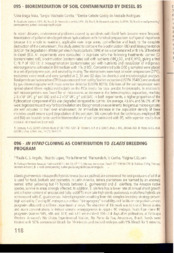In vitro cloning as contribution to Elaeis breeding program.
In vitro cloning as contribution to Elaeis breeding program.
Autoria: ANGELO, P. C. da S.; LOPES, R.; PIMENTEL, P.; CUNHA, R. N. V. da; QUISEN, R. C.
Resumo: Elaeis guineensis intraspecific hybrids tenera(dura x pisifera) are considered the best producers of oil that is used for food, biofuels and cosmetics. In Latin America, tenera plantations are harmed by an anomaly named lethal yellowing but F1 hybrids between E. guineensis and E.oleifera, the Amazon native species, survive in are as strongly affected. In addition, E. oleifera has a lower rate of annual shoot growth andda higher content of un saturated fatty-acids. To maintain high yields guineenis x oleifera hybrids are retrocrossed with E. guineensis. Indeed progenies resulting from this complex breedings trategy presenthigh variability. Cloning RC embryos can reduce"intraprogeny"variabilitybandbfacilitatebcomparison among progenies allocated to different experimental areas. The objective of this work was to test different auxins and auxin concentrations to induce somatic embryogenesis in zygotic RC embryos. Fruits from three Reprogenies(named 585,586 and 321) and a F1 were collect 100+2.4 days after pollination, at Embrapa Western Amazon's Rio Urubu Experimental Station, Rio Preto da Eva, Amazonas, Brazil. Seeds were treated with 50% commercial bleach for 10 minutes and excised embryos with 5% bleach for 5 minutes. Explants were cultivated in MS medium and vitamins supplemented with 110, 150 and 200mg. L'2,4-diclorophenoxiaceticacid(2,4-D) or 186mg. L-1 naphtalenacetic acid (NAA) . Frequencies of primary (PC) x embryogenic calli(EC) observed in six months were compared by chi-squared tests. In the sixtieth month 29% (108/375) explants were alive. The rest was discarded by oxidation, hardening and stop reacting, rooting and contamination. Regardless the auxin used,the frequency of PC (18%) was higher than that of EC (11 %) what differed among progenies(P=0.005).150mq.l'2,4-D influenced the frequency of EC indifferent progenies(P=0.005) and the induction of 24% EC in progeny 585(P<0.001). For progenies F1 and 586, different concentrations of 2,4-D were not related to callus types. For progeny 321,2,4-D and NAA were compared and none of them could be linked to different callus types. Calli indyction with 2,4-D was simultaneous to development of shoots. Granular yellow ish calli were more frequent. NAA induced compact,white, opaque nodula r calli more frequently, which are apparently polyembryogenic complexes resulting from direct embryogenesis In conclusion we suggest that differences among progenies are pronounced than the effects of different auxins. Concerning is the low frequency of embryogenic calli obtained because it can turn difficult to represent satisfactorily the genotypes with in progenies.
Ano de publicação: 2010
Tipo de publicação: Resumo em anais e proceedings
Unidade: Embrapa Amazônia Ocidental
Observações
1 - Por padrão são exibidas publicações dos últimos 20 anos. Para encontrar publicações mais antigas, configure o filtro ano de publicação, colocando o ano a partir do qual você deseja encontrar publicações. O filtro está na coluna da esquerda na busca acima.
2 - Para ler algumas publicações da Embrapa (apenas as que estão em formato ePub), é necessário ter, no celular ou computador, um desses softwares gratuitos. Sistemas Android: Google Play Livros; IOS: iBooks; Windows e Linux: software Calibre.
Acesse outras publicações
Acesse a Base de Dados da Pesquisa Agropecuária (BDPA) para consultar o acervo completo das bibliotecas da Embrapa.

